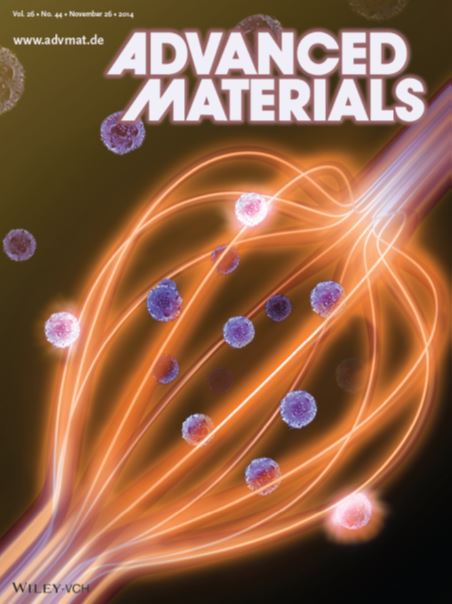Peking University, Nov. 25, 2014: Rapid detection and sizing of nanoscale particles are of increasing importance in various fields, such as early-stage biomedical diagnostics and treatment, process control of semiconductor manufacturing, and explosive and environmental monitoring. Recently, a group led by Professors Xiao Yun-Feng and Gong Qihuang at Peking University, collaborating with their colleagues from Zhejiang University, has developed a novel nanofiber-array sensor, and experimentally demonstrated its potential in the detection and sizing of single nanoparticles in an aqueous environment. The result was published in Advanced Materials as a front cover story (DOI: 10.1002/adma.201402085).

A nanofiber array for single nanoparticle detection, shown on the front cover of Advanced Materials, issue 44/2014.
Over the past few years, it has been demonstrated that when the diameter of an optical fiber is reduced to the scale of an optical wavelength, there is a strong evanescent field outside the nanofiber, which is very sensitive to the refractive index change of the surrounding medium. Optical nanofiber biosensors are being extensively investigated due to their advantages of having a simple configuration, low cost, label-free property and remote-sensing capability.
In this work, the researchers fabricated nanofiber pairs with uniform diameter, and placed them into a microfluidic channel. “When nanoparticles in the microfluidic channel are attached to the nanofiber surface, the transmitted power decreases, because the nanoparticles scatter and absorb a portion of the evanescent light,” said Yu Xiao-Chong and Li Bei-Bei, the two Ph.D. students in Xiao’s group. Benefiting from the strong evanescent fields of the nanofibers, the decrease in the transmitted power induced by an individual nanoparticle is typically larger than the noise level.
By monitoring the step changes in the transmission of the nanofiber, detection and sizing of nanoparticles with single uniform radius (~ 100 nm) and of mixed nanoparticles with two different radii (100 nm and 170 nm) are both realized in their experiment. Moreover, by employing plasmonic enhancement, detection of single gold nanorods with much smaller sizes (diameter ~ 16 nm, length ~ 40 nm), is also demonstrated.
"Another advantage of this new sensor is that the nanofiber pair can be easily extended to an array containing more nanofibers with uniform diameter, which is important for achieving sensing with short response times,” said Professor Xiao, the leading scientist of the project. “This promises a bright future for fast biodetection by using label-free nanofiber sensors.”
Edited by: Zhang Jiang
Source: School of Physics